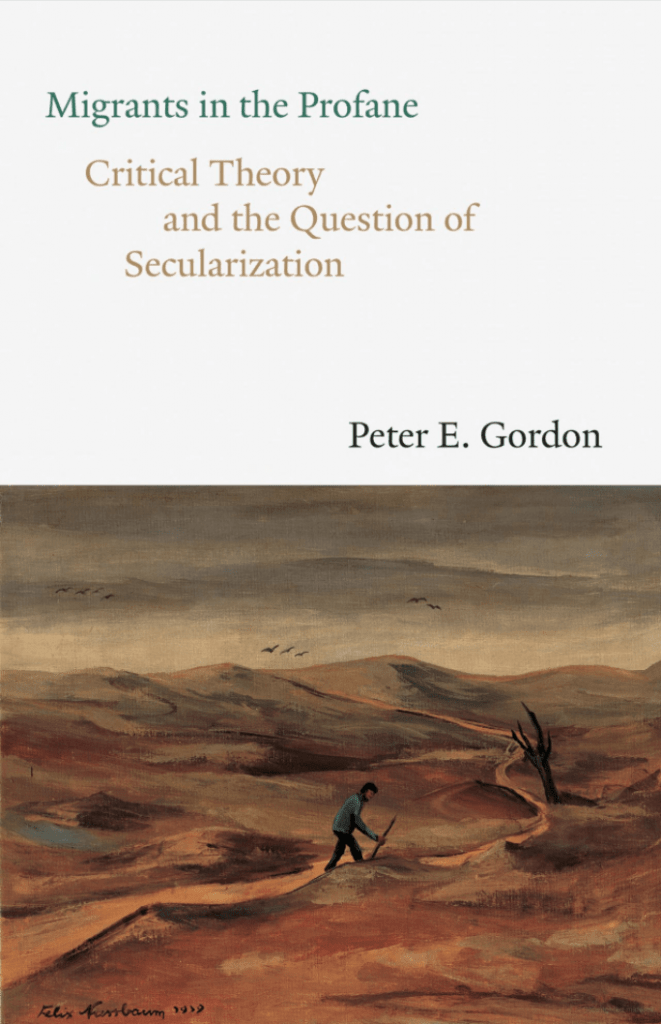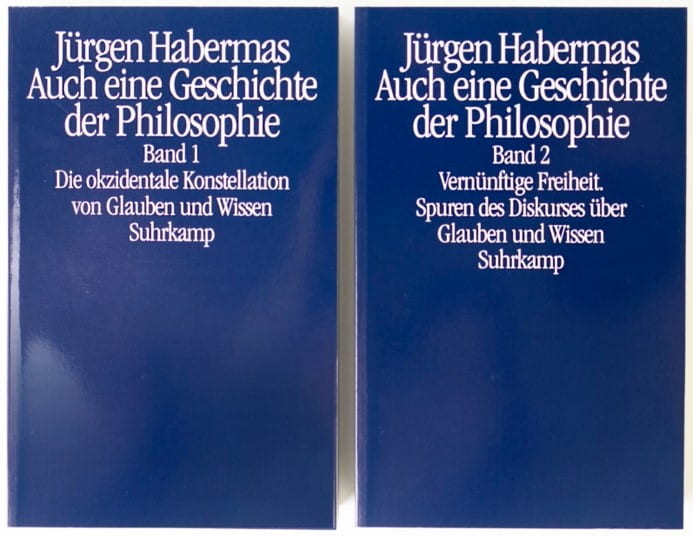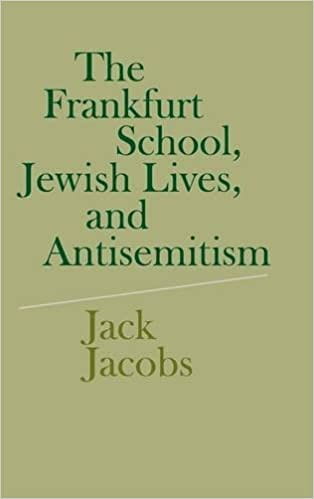By Jonathon Catlin
Peter E. Gordon is the Amabel B. James Professor of History and Faculty Affiliate in German and Philosophy at Harvard University. He is the author of many books, including Rosenzweig and Heidegger: Between Judaism and German Philosophy (2003) (which received the Forkosch Prize from the Journal of the History of Ideas), Continental Divide: Heidegger, Cassirer, Davos(2010), and Adorno and Existence (2016). His latest book, Migrants in the Profane: Critical Theory and the Question of Secularization(Yale University Press, 2020), is based on the Franz Rosenzweig Lectures in Jewish Thought that he delivered at Yale University in 2017. It explores the work of three of the most esteemed thinkers in the early canon of Frankfurt School critical theory: Walter Benjamin, Max Horkheimer, and Theodor W. Adorno. As Jürgen Habermas writes in his blurb of the book, Gordon illuminates “the deepest and darkest thought” these thinkers confronted: “How to save the truth content of religious traditions for the sake of secular modernity while denying at the same time its very foundation in religious belief.” This work of judicious intellectual history ultimately recuperates secularism as a normative ideal for our “post-secular” age. Gordon recently wrote a freely-available essay on this topic for The New Statesman. Contributing editor Jonathon Catlin interviewed him about his new book.
Jonathon Catlin: The title of your book comes from Theodor W. Adorno’s 1957 essay “Reason and Revelation,” in which he comments on his late friend Walter Benjamin’s famous image of a mechanical chess player with a “theological” animus, a dwarf hidden inside: “Nothing of theological content will persist without being transformed; every content will have to put itself to the test of migrating into the realm of the secular, the profane” (136). A few years later, Adorno added, in a letter to their mutual friend Gershom Scholem, that this migration had to be “rücksichtslos,” ruthless or without regret (111). This motif of migration you trace in Adorno’s thought resonates with themes of persecution and uprootedness in Jewish history, as well as Martin Jay’s apt description of the members of the Frankfurt School as “permanent exiles” (another title, you note, that he considered for The Dialectical Imagination). Could you say more about this passage and how it exemplifies the broader ambitions of your book?
Peter E. Gordon: I have long been fascinated with the problem of secularization. While working on a far more systematic project about secularization and social thought (which I fear I won’t finish for many years), I was honored to receive an invitation to deliver the lectures at Yale, so I seized the opportunity to think in a provisional way about some of the concepts of secularization that appear in the works of the early thinkers in the Frankfurt School tradition of critical theory, Benjamin, Horkheimer, and Adorno. It’s especially striking that on several occasions Adorno refers to the idea of secularization as a “migration into the profane,” and variations on this idea appear in several places throughout his work. I revised the lectures into a book while living in Europe during some of the worst months of the migration crisis, when refugees were fleeing the murderous civil war in Syria. Because migration poses special challenges for pluralistic democracies, I felt it was an urgent matter to reflect upon the significance of Adorno’s figure of migration in relation to the secular premises of the modern democratic state. My reflections on the migration crisis itself are provisional, merely a set of theoretical prolegomena to more substantive thoughts that I hope to develop elsewhere.
The heart of the book is an attempt to reconstruct some philosophical problems that arise in relation to the concept of secularization as it appears in the writing of Benjamin, Horkheimer, and Adorno. I find it truly striking that this concept plays such an important role in their work, but it’s important to note that they thought about it in remarkably different ways. I wanted to bring out some of those differences, while placing some analytical pressure on moments of ambivalence or aporia in their arguments. But I could hardly neglect the historical experiences of the authors themselves. Critical theory, after all, first emerged in the crucible of a European culture that was descending into fascism. The persecution and exile of the Frankfurt theorists is not incidental; such experiences are scored right into even their most abstract reflections on philosophy and art. For the Frankfurt School theorists, exile was not only a biographical trauma, it was also a figure of thought: the image of what does not fit into a seamless totality of reason, of what remains “negative” and, in its negativity, serves as a point of leverage for critical practice. What Georg Lukács elsewhere calls “transcendental homelessness” becomes, one might argue, the condition of possibility for critical theory itself.
JC: In this book, you “explore the problem of secularization, not as a social process, but as a conceptual gesture” (1) employed by three secular thinkers who “borrow from the conceptual archive of theology” (59). To begin with your reading of Benjamin’s Denkbild of the chess-playing automaton, we see that secularization here describes “not the disappearance of religion but only its concealment” in a hidden messianic drive in history that might be turned toward revolutionary rupture (34). While Scholem saw Benjamin’s historical materialism as a mere dressing up of the theological core of his thought, and the Marxian New Left who also claimed Benjamin were embarrassed by such theological allusions, you present these interpretations as two sides of the same paradox: Benjamin “stages a permanent contest between Marxism and messianism” (59) since his “appeal to the messianic became the radical antidote for his own radical portrait of disenchanted history” (79). Yet you remain skeptical of Benjamin’s view, for as Adorno wrote, “If religion is accepted for the sake of something other than its own truth content, then it undermines itself” (96). Under what conditions do you think religious ideas can and should still inform these theorists’ common aim of redeeming a broken world?

PG: Although I have enormous admiration for his work, my quarrels with Benjamin are profound. His thinking was creative but unruly, exploratory in the best sense but rarely committed to standards of rational argumentation. My quarrel fastens chiefly on the way in which he resorts to theological categories at the most crucial junctures in his political thought. If Benjamin wishes to defend a species of historical materialism, it seems to me that he cannot at the same time appeal to a principle that lies beyond history and intrudes upon it as if from the outside. We can appreciate why he found himself in such a predicament: at the time he was writing his famous “Theses,” the Hitler-Stalin pact had exposed the absolute futility of any hopes for an imminent revolution. Benjamin therefore portrays history as a field of ruins, borrowing imagery of blasted landscapes and catastrophe that he had explored long before in his ill-fated habilitation on the mourning-plays of the German baroque. History became disenchanted: a plenum without meaning and without immanent resources that would be necessary for human happiness.
This disenchanted understanding of history also informs his interpretation of von Kempelen’s chess-playing Turk. Benjamin sees the chess player as a “dialectical image,” an allegory for historical materialism, which, he fears, has become as lifeless and mechanistic as the automaton (especially as it had been developed in the technological optimism of Bernsteinian revisionism). If it is to fulfill its purposes as an explanation for history, Benjamin argues, historical materialism must avail itself of a principle that is exotic to materialist thinking. He finds this principle in the theological concept of historical rupture—of discontinuity or the messianic. Benjamin knows, however, that in the modern, secular world, theology has lost much of its prestige and is seen as invalid. Thus, theology must be “hidden,” like the dwarf who is concealed in the chess player’s cabinet. Secularization for Benjamin does not mean the dissolution of religious values; it means only their concealment.
Here Benjamin falls into self-contradiction. Historical materialism must see change as emerging from dialectical contradictions that are immanent to history itself. The appeal to an extra-historical principle violates this understanding. This is not a problem specific to Benjamin; we encounter an analogous problem in modern political theory. Any principle that could be a candidate for democratic consent in modern political discourse needs to be exposed to critical scrutiny, not concealed from debate. Here we may discern a troubling similarity between Benjamin and Carl Schmitt. The Schmittian suggestion that an extra-systemic, religious principle could serve as the unquestionable and hidden ground for politics violates this principle. It threatens our ideal of the public sphere as a neutral medium of rational contestation. In practice, of course, that ideal is too often applied selectively or transgressed. But if we abandon it, we can easily slip back into an authoritarian order where only one religion holds sway. Under modern conditions of ethno-religious pluralism this threat needs to be taken seriously, as we see in cases across the globe, from the Hindu nationalism in Modi’s India to the evangelical Christianity here in the States.
JC: Jürgen Habermas, famous as a theorist of secular modernity, became interested in religion as a source of normativity in the early 2000s, after 9/11 and the dawn of what he called a “post-secular age.” In his massive two-volume 2019 work, Auch eine Geschichte der Philosophie (This Too a History of Philosophy), he cites you as one of his most important interlocutors. This work reconstructs the millennia-long dialogue between reason and faith as a “learning process” through which secular reason might still inherit insights from religion without violating the proviso that religious values must be subjected to public criticism. Your book ends in broad agreement with this Habermasian view, which your reading identifies in nuce already in Adorno. I was curious about your admission that you changed this book’s subtitle from the concept of secularization to the question of secularization. What do you find so urgent yet unresolved about this notion?
PG: I have learned a great deal from Habermas. Although I would hardly boast that I’m one of his most important interlocutors, my little book is in close dialogue with his recent work, including the formidable two-volume tome that you mention. I wrote my book around the same time, and completed it before I had the chance to finish reading his own remarkable manuscript. I believe that in the concluding footnote Habermas cites my book by its original subtitle, where secularization is called a “concept.” Some time after he had read my manuscript, I modified this subtitle, simply because secularization remains so very much in question. Academic debates over the meaning of both secularization and “the secular” are ongoing and are unlikely to be resolved. They reflect broader public contestation around the globe as to what political frameworks might be preferred if we are to live in a society that will embrace what Adorno called “difference without domination.” But the further one digs into the theoretical literature, the more one realizes that secularism does not signify a self-identical concept or ideology; it maps out a broad field of semantic and political possibilities (not unlike religion itself). But the question is indeed urgent: if we are to accept the ethno-religious heterogeneity of modern society, we have to agree upon some common framework of political coexistence. Some theorists in recent years have quarreled with “secularism” because they are suspicious of its paradoxical and often coercive effects. They are right to be suspicious, and if they are allergic to the particular term this isn’t altogether surprising. But they cannot absolve themselves of the need to propose some framework that allows for heterogeneity to persist.
JC: It is well known that most of the members of the Frankfurt School were of Jewish descent, but there is little agreement about the significance of this fact. There are approaches like Jack Jacobs’s The Frankfurt School, Jewish Lives, and Antisemitism(2014), which Anson Rabinbach says creates “a kind of identity politics for the Frankfurt School” by embracing Gershom Scholem’s quip that it was one of “the three most remarkable ‘Jewish sects’ that German Jewry produced” (p. 131). Skeptical of that identitarian approach, you emphasize the theorists’ diverging relations to Judaism and Jewishness. More apt might be Isaac Deutscher’s sociological category of “the non-Jewish Jew.” You seem to prefer Michael Löwy’s even more qualified approach positing an “elective affinity” between modern Jewish experience and utopian or socialist politics. You write that “we should resist the temptation of reducing philosophy to biography” (7–8), and this methodological approach resonates with the ethical call in your conclusion to embrace the non-identical migrant within ourselves; with nods to theorists of multiculturalism including Seyla Benhabib and Jürgen Habermas, you write, “it is only through a disenchantment of collective identity that we can achieve the kind of institutionalized coexistence that is crucial to our shared life today” (154). Is there any role for Jewish identity in the study of the Frankfurt School?
PG: I think it’s mistaken to assign too much explanatory weight to the Jewish identity of the first-generation Frankfurt School theorists. To be sure, I can appreciate that under conditions of social exclusion or persecution, groups often find comfort and solidarity in the fact of a shared cultural identity. But such bonds are not eternal; they are historically contingent and change over time. No essence of identity expresses itself in thought. Löwy’s thesis of an elective affinity is useful because it reminds us of the purely sociological reasons why so many Central-European intellectuals of Jewish descent were drawn into radical or socialist politics. That affinity nourished a long and varied tradition, from Heine to Marx to Luxembourg (to name just a few). The list is indeed a long one. But as the social conditions of exclusion no longer obtain as they once did, so too have the conditions that once encouraged this affinity. In general, I’m not a great partisan of identity: it forges bonds of connection but it also polices boundaries, and one can hardly avoid the contrastive logic by which all inclusion also implies exclusion. This is why I say that under conditions of modern pluralism we must recognize that identitarian attachments have ambivalent effects. Through the challenge of an encounter with difference, our own identities become relativized and our group boundaries become porous. And this has important consequences for how we think of ourselves: the more self-reflexive we become about the significance of group-attachments, the more we begin to realize that the social multiplicity we see outside us also works upon us from the inside. The self is not self-identical; it is multiple. The objective fact of social pluralism also implies a kind of internal secularization, whether we like it or not. More generally, I would say that the sacral bonds of community simply cannot remain what they once were. The disenchantment of collective identity seems to me an urgent necessity if we don’t wish our encounter with difference to devolve into a so-called clash of civilizations.
JC: I am also interested in whether we might, alternatively, consider the theorists’ relations to Judaism and Jewishness one of non-identity or what Eric Oberle has called “negative identity.” Felix Nussbaum, who painted The Wandering Jew (1939) on the cover of your book, was a German-Jewish painter who was murdered at Auschwitz, and the Holocaust looms large in the background of your study. The first generation of the Frankfurt School was, as we discussed earlier, “united by trauma” through their shared experience of antisemitism and exile (104). I think you are right to claim that Adorno did not “in any straightforward sense” see himself as a “full-fledged member of the Jewish milieu” (106, 109). However, across his postwar writings on the Holocaust, when he asked “whether one who escaped by accident, one who by rights should have been killed, may go on living” (Negative Dialectics, 363), I see him as expressing solidarity with Jewish victims in a way that clearly implicates himself. You quote a 1943 letter to his parents in which he wrote, “I am totally Jewified, i.e. have nothing but anti-Semitism on my mind” (109). At that time, of course, he and Horkheimer were deeply preoccupied with the Jewish question. Would you admit the possibility of critical forms of identification, such as with the experience of exile, that are not necessarily rooted in ethno-nationalist forms of identity? Relatedly, you criticize the tendency to include Adorno in the canon of modern Jewish thought (174), yet your book develops an analogy between Adorno’s negative dialectics and the negative theology of Maimonides. Might we consider Adorno a thinker of Jewishness if not of Judaism?
PG: There are many issues here. You are of course right that we can distinguish between contingent modalities of identification and quasi-eternal facts of identity. This is an elegant distinction. And this is what I meant before about the social conditions of solidarity. But this distinction is not stable: identification is easily naturalized, and hardens into something reified, or seemingly natural that then becomes identity. Even a “negative identity” may not escape this problem. Adorno was not Jewish by conviction, nor by practice, though he was raised in a primarily German-Jewish milieu, and the fact of his father’s Jewish heritage ultimately determined his fate when the Nazi racial laws came into effect. It’s important, however, that we do not seek retroactively to impose on him a group identity he would have abjured as a matter of philosophical principle. “Jewishness” is a term of ethno-national attachment, and I fear that it’s not suitable for a thinker such as Adorno, who was simply too contrarian to welcome such bonds. Even in his early years Adorno developed a strong hostility to collective identity. This may reflect his debt to Kierkegaard, who fulminated against the mindlessness and conformism of bourgeois Christendom. All the same, the experience of persecution and exile is taken up in his work as a philosopheme, as a figure of negativity, and as a condition for the possibility of critique.
The lecture series at Yale is defined as a series that should speak to topics in modern Jewish thought; it was chiefly due to this assignment that it seemed appropriate to offer some reflections on questions of Judaism and Jewish philosophy. I find the comparison between Adorno and Maimonides intriguing: negative dialectics bears some resemblance to negative theology. (My colleague James Gordon Finlayson has explored the comparison by looking at Pseudo-Dionysius, another important figure in the tradition of negative theology.) But, ultimately, I would say that the comparison breaks down: Maimonides pursues the via negativa to liberate us from idolatry and illusion such that we may arrive at a proper understanding of the divine. Adorno pursues the via negativa to liberate us from the illusions of ideology, but he does not stop short before any kind of final or metaphysical truth. Instead he uses the critical energies of the negative without restraint: he pursues it right into the heart of theology itself where it dissolves the metaphysical object it was originally meant to serve. He would loathe the thought that this negativity is only a passing moment on the way to reconciliation.
JC: All three critical theorists you discuss employed theological ideas to unsettle the seeming naturalness and necessity of the contingent and flawed present social order. They saw the horizon of another possible world as helpful, perhaps even necessary, for challenging “the positivistic affirmation of the given” and “the compulsory affirmation of what is already the case” (82). As Horkheimer said in a 1967 radio address, “Christianity and Marxism are not opposed but rather share in common the critical function of relativizing what happens to exist. Christianity relativizes existence as mere finitude in contrast to the divine; Marxism relativizes existence as merely a stage in prehistory in contrast to the socialist future” (76). The essence of religion, Horkheimer wrote in his preface to Jay’s The Dialectical Imagination, is the yearning for the “wholly other,” the hope that “earthly horror does not possess the last word” (64). In your view, Horkheimer, like Benjamin, goes too far and departs from immanent critique. You prefer Adorno’s more dialectical situation at the juncture of the sacred and the profane, which navigates between the kind of dogmatic, metaphysical atheism you have criticized in the work of Martin Hägglund and the regressive re-sacralization of the world with which Adorno charged existentialism and its “jargon of authenticity” (140–41).While Adorno wrote that secularization“preserves theology in its critique of it” (139), leading some to claim that negative dialectics constitutes a “secular Jewish theology,” you argue that the theological gesture in Adorno is “merely conceptual” and persists “only as an idea,” for he ultimately gave secular criticism the last word: “negative theology completes itself in negative dialectics” (140). Through Adorno’s work you identify a transcendental maxim for critical thought: “we are compelled to postulate—if only for the sake of our own criticism—a standpoint removed, at least conceptually, from the world we confront before us and whose conditions we take for granted as factually given” (112). Does this maxim still hold today? What are its implications for contemporary thought?

PG: Horkheimer was a philosopher of great subtlety and sophistication. But toward the end of his life, the pessimism that he had absorbed in his early years from Schopenhauer discouraged him from acknowledging the possibility of an immanent transformation of society. He succumbed to a species of fatalism to which religion beckoned as the only viable alternative. Even if he is right that the theological concept of the “wholly other” stands opposed to earthly horror, it’s not clear why this concept can actually furnish a remedy for the horrors we have made here on earth. His thoughts on this matter lead to the same aporia as we saw in Benjamin: he appeals to a transcendent principle as a resolution to social pathologies that should be healed on immanent terms. Adorno is more careful: he recognizes in theology not a remedy to our problems but only a concept providing a critical vantage from which those problems become visible. This is why I believe it was misleading for Martin Hägglund to characterize Adorno as a “religious thinker.” The challenge here is to think, with the left-Hegelian tradition, in a truly dialectical fashion by avoiding the stark contrast between what is religious and what is secular as if these were pure and wholly separable spheres. The gesture of secularization as it appears in philosophy cuts across that dualism. It is dialectical and truly dynamic, a movement from the one to the other.
I don’t have the temerity to suggest what this might imply for contemporary thought. I would only say, following Habermas, that secularism need not be secularist in the dogmatic sense, because secular frameworks of government seem to be a helpful way of permitting a diverse citizenry, both religious and non-religious alike, to co-exist. Any philosophical argument for “secularism” has to honor this principle and it should not ignore the empirical fact of a global condition of ethno-religious heterogeneity. Many people on this planet are religious. We may find this regrettable or appealing. But we are not going to get very far if we begin from the premise that radical atheism is the ultimate truth of the matter while we dismiss theism as little more than a metaphysical error. Heideggerian hymns to human finitude have little bearing on the practical question as to how we might structure our political institutions here and now so that they are more inclusive and socially equitable.
JC: Some might be surprised by your book’s conclusion: Adorno, a thinker notorious for his pessimism, emerges as the most optimistic of the trio you examine, since Benjamin and Horkheimer “opened themselves to a disabling skepticism about the very possibility of modern life” by imagining “only religion as the solution to our social affliction,” thus positing a normative deficit that only messianic rupture or the wholly other could rectify (141). By contrast, Adorno drew upon theological ideas but ultimately “sustained a principled commitment to the dialectical redemption of secular society from within” through secular criticism (142). Might we call the Adorno that emerges from your intellectual portrait something like a hopeful atheist?
PG: I would resist the suggestion that he was either hopeful or a pessimist, chiefly because he’s too complex a thinker for such terms to apply. If Adorno is notorious for his pessimism, this is only because popular understanding misses much of what is truly exhilarating in his work. I tried to argue this point in my 2019 Adorno Lectures in Frankfurt. Adorno did not see the world in Gnostic terms as fallen into total darkness, and it’s a mistake to see him as some kind of scowling but privileged contrarian, a modern Mephistopheles who could never affirm but only negate. That image of Adorno circulates everywhere, of course, and it’s often interlaced with insinuations of elitism and wealth that too often activate the old vocabularies of antisemitism. None of this is accurate. Worst of all, perhaps, is the frequent complaint that his exacting aesthetic standards cannot be made to harmonize with his political aspirations. This complaint is mistaken; they cohere as two moments in an image of flourishing humanity. As Iain Macdonald explains quite brilliantly in his recent book, notwithstanding all of his critical negativity Adorno held fast to figures of real possibility. He recognized in moments of human happiness—not only in modern art but also in our embodied experience as natural beings—the normative promise of a world that might truly be otherwise than it is.
JC: Your book offers its own response to the problem of the so-called “normative deficit” of secular modernity. Invoking Habermas, you consider sources of normativity as at once “ideology and simultaneously more than ideology” (14). Your approach is critical of “an increasing number of intellectuals on the left [who] have adopted the self-sabotaging posture of generalized skepticism” and who “affirm only power as the highest reality and regard the old ideals of universal justice with cool disbelief” (13). In the midst of myriad crises and pervasive suffering today, you reject this “one-sided critique of ideology” associated with Nietzsche and Foucault in favor of the “genuinely dialectical” approach of critical theory (14). You quote from Adorno’s 1965 lectures on Metaphysics, it is “one of the most dangerous errors now lurking in the collective consciousness to assume that because something is not what it promises to be, because it does not yet match its concept, it is therefore worse than its opposite, the pure immediacy which destroys it” (16). How might the secularized religious concepts you discuss provide models for holding onto enlightenment ideals in an age of skepticism and disillusionment?
PG: I have written elsewhere about the problem of a normative deficit of modernity, namely, the idea that modern society suffers from a scarcity of moral-political norms for which religion alone may serve as a remedy. Max Weber was one important exponent of this idea, though he is not the only source, and it has enjoyed a remarkable longevity in social theory, accompanying the theory of secularization like a dark shadow. Genealogies of secularism are now enjoying a curious popularity, and I think this is welcome, at least in a certain measure. Genealogy can serve as an important critical instrument insofar as it unsettles comfortable assumptions and exposes the paradoxes of our ideals when they are put into practice. But a one-sided genealogy that becomes a mere exercise in skeptical dismantling has serious limitations. Even while we recognize how ideals are entangled in ideology, we can’t be disburdened of the need to pursue our political ideals. Genealogy, too, is a mode of critique: it exposes the dissonance between ideals and practices, and it is animated by outrage when a given practice does not live up to its concept. But any critique has to make explicit the normative principles that animate it. It’s important that we do not simply shrug off the task of philosophical justification. The tradition of critical theory emanating from Frankfurt is salutary insofar as it sustains a dialectic (admittedly unresolved) between normative justification and social critique. To insist that we choose between these two tasks would be a philosophical error.
Jonathon Catlin is a Ph.D. Candidate in the Department of History and the Interdisciplinary Doctoral Program in the Humanities (IHUM) at Princeton University. His dissertation is a conceptual history of catastrophe in modern European thought. He tweets @planetdenken.
Featured Image: Book jacket, Felix Nussbaum, The Wandering Jew (1939). Felix-Nussbaum-Haus in the Museumsquartier Osnabrück, loan from the Niedersächsische Sparkassenstiftung. Copyright/photo credit: Museumsquartier Osnabrück, Felix-Nussbaum-Haus.







2 Pingbacks